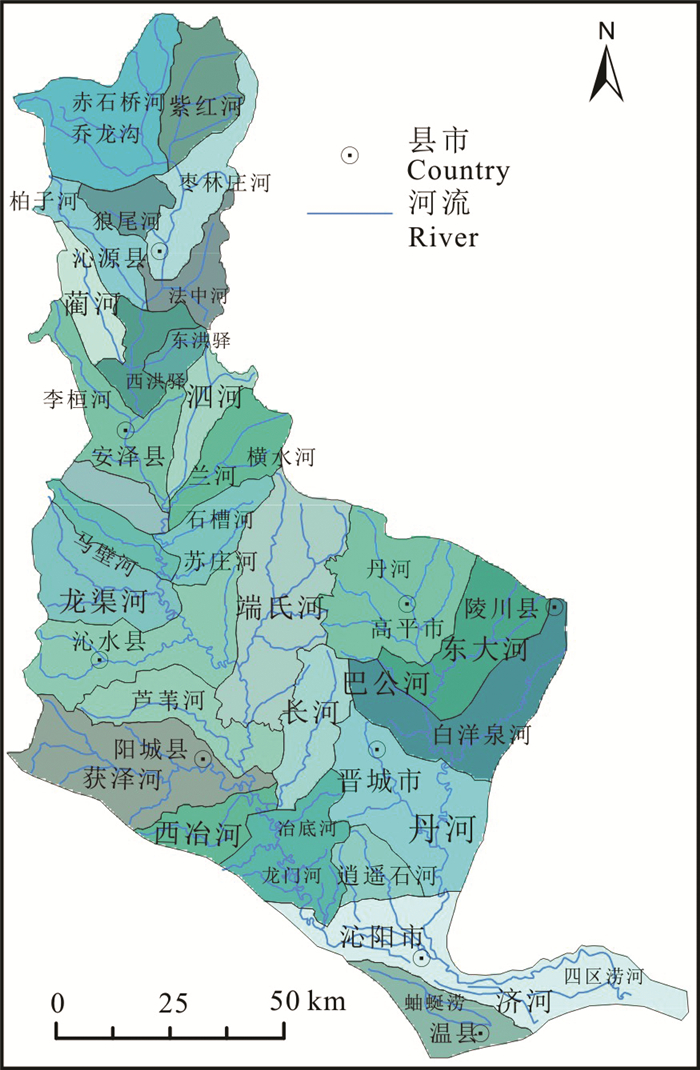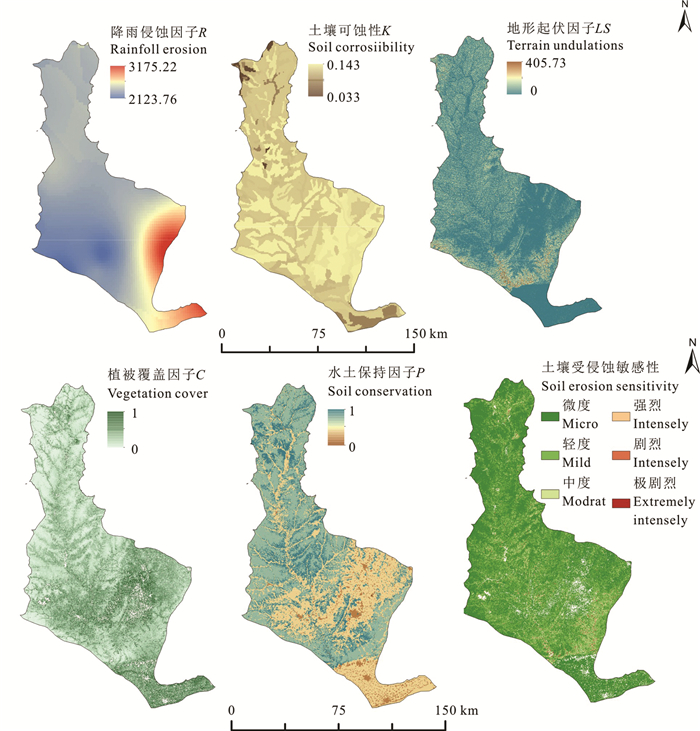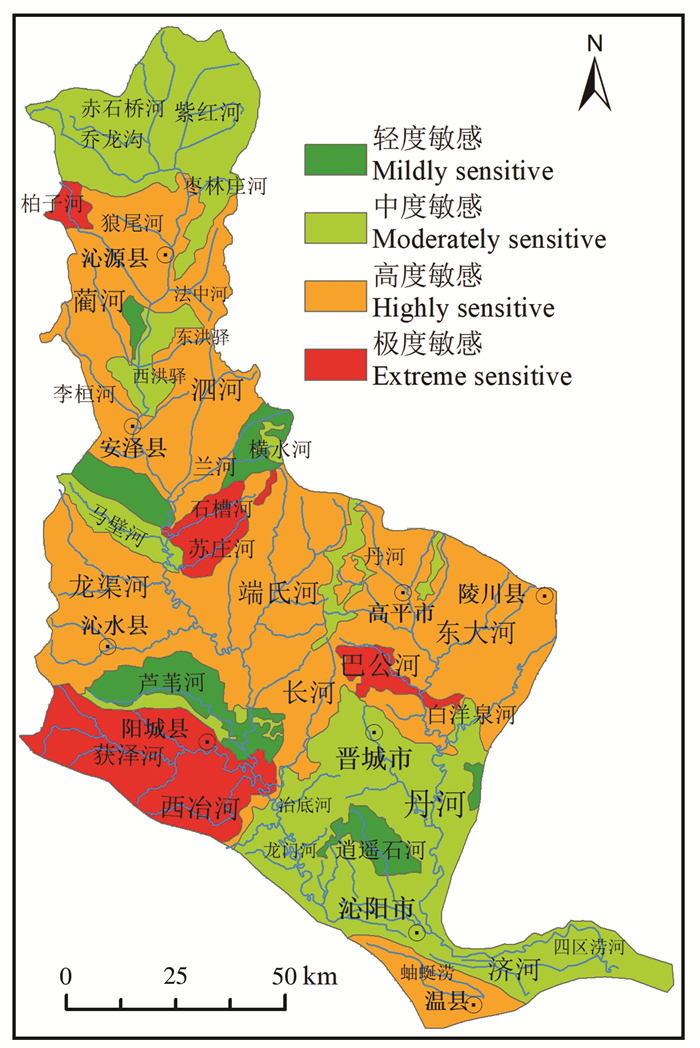Analysis and evaluation of environmental sensitivity in the Qinhe River Basin in the middle reaches of the Yellow River
-
摘要:
研究目的 沁河流域作为黄河流域重要的一级支流,也是黄河流域的重要水土保持功能区,当前面临着水环境遭受破坏以及土壤侵蚀这两个敏感环境问题,环境敏感性评价是用于表征外界干扰对自然生态系统可能造成结果的重要指标,对区域建立生态涵养区的环境政策以及有效进行区域生态建设具有重要作用。
研究方法 根据研究区面临的不同环境地质问题选取了层次分析法(AHP)与RUSLE模型的评价方法以及相关因子,并结合GIS空间数据技术强大的空间分析功能,将图形处理与空间数据运算结合,生成敏感性评价图,评价结果直观,为环境敏感性分析提供了技术支持。
研究结果 针对沁河流域的环境敏感性进行评价,并划分为轻度、中度、高度、极度4类敏感区域,进行统计分析,得出流域内以中、高度敏感区域占比最大,分别占总面积的33.43%、48.56%,同时以各支流流域为依托,针对各类敏感区域的主要环境问题,对其环境现状产生的原因及改善方法提出了相应的调整方案。
结论 依据各区域环境现状及敏感性程度提出了沁河全流域的生态环境保护修复思路,构建一个山地生态系统和平原生态系统有机结合的生态网络格局,致力于改善沁河流域的生态环境现状。
Abstract:This paper is the result of hydrological geological survey engineering.
Objective As an important first-class tributary of the Yellow River Basin, it is also an important functional area for soil and water conservation, the Qinhe River Basin is facing two sensitive environmental problems, water environment destruction and soil erosion. Environmental sensitivity evaluation is an important measure of external interference with natural ecosystems. It plays an important role in carrying out regional ecological protection.
Methods Based on the different environmental geological problems faced, the evaluation methods of analytic hierarchy (AHP) and RUSLE models were selected. Moreover, combined with the powerful spatial analysis function of GIS spatial data technology, sensitivity evaluation maps were generated by integrating graph processing and spatial data operation. The evaluation results were intuitive, which provided technical support for environmental sensitivity analysis.
Results After assessment, it can be divided into four types of sensitive areas, that is, mildly sensitive areas, moderately sensitive areas, highly sensitive areas and extremely sensitive areas. Statistical analysis shows that moderate and highly sensitive areas account for the largest proportion, reaching 33.43% and 48.56% of the total area, respectively. At the same time, based on each tributary basin, the author puts forward the corresponding adjustment plans to the causes and improvement methods of the environmental status, aiming at the main environmental problems facing each type of sensitive areas.
Conclusions According to the environmental conditions and sensitivities of each region, the ecological environmental protection and restoration idea was put froward, and an ecological network pattern combining mountain and plain ecosystems is constructed to improve the ecological environment of the Qinhe River Basin.
-

-
表 1 水环境因子权重与评分标准
Table 1. Weight and scoring standard of water environmental factors

表 2 水土保持因子P赋值
Table 2. Assignment of water and soil conservation factor P

表 3 沁河流域各级土壤侵蚀面积统计表
Table 3. Statistics of soil erosion area at all levels in the Qinhe River Basin
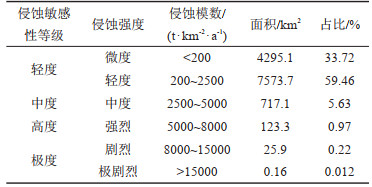
表 4 沁河流域环境敏感性特征值
Table 4. Characteristic values of environmental sensitivity of the Qinhe River Basin

表 5 沁河流域环境敏感性面积统计表
Table 5. Statistics of environmental sensitivity area in the Qinhe River Basin
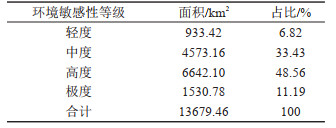
-
Adamczyk J, Robert D. 2017. Analysis of the sensitivity of the ecological effects for the investment based on the thermal insulation of the building: A polish case study[J]. Journal of cleaner production, (162): 856-864.
Bergengren J C, Waliser D E, Yung Y L. 2011. A biospheric view of climate change[J]. Climatic Change, 107(3/4): 433-457.
Changzhi Investigation Team of the National Bureau of Statistics. 2020. Changzhi Statistical Yearbook 2020[M]. Beijing: China Statistics Press, 1-688(in Chinese).
Chen Shuang, Ma Anqing, Ma Bingran, Li Zhengyan, Jiao Junchao, Cui Jinglan. 2015. Assessment on eco-environmental sensitivity in Daliaohe Area[J]. Periodical of Ocean University of China, 45 (9): 103-108(in Chinese with English abstract).
Chen Shuwang, Xing Dehe, Ding Qiuhong, Zheng Yuejuan, Gao Fei, Bian Xiongfei, Zhang Zhibin, Antonina A Zhukovskaya, Irina V Ershova, Nadezhda A Tomilovskaya. 2012. Ecogeological survey and Evaluation: A case study of Tieling Area, Liaoning Province[J]. Geology and Resources, 21(6): 540-545(in Chinese with English abstract). doi: 10.3969/j.issn.1671-1947.2012.06.008
Chen Wen, Huang Zhenkun, Zhao Haixia, Cui Xu. 2008. Regionalization of water environmental risk and spatial development guidance: A case study of Wuxi City[J]. Journal of Lake Science, (1): 129-134(in Chinese with English abstract). doi: 10.3321/j.issn:1003-5427.2008.01.020
Cheng Guoqi. 2016. Analysis of eco-environmental problems and restoration suggestions in Qin River Basin[J]. Shanxi Water Resources, (7): 10-11(in Chinese). doi: 10.3969/j.issn.1004-7042.2016.07.007
Ding Hui, Zhao Xiaomin, Guo Xi. 2020. Evaluation of ecological sensitivity in Poyang Lake area of Jiangxi Province[J]. Research of Soil and Water Conservation, 27(1): 257-264(in Chinese with English abstract).
Glisson W J, Brady R S. 2015. Sensitivity of secretive marsh birds to vegetation condition in natural and restored wetlands in Wisconsin[J]. Journal of Wildlife Management, 79(7): 1101-1116. doi: 10.1002/jwmg.937
Han Shuangbao, Li Fucheng, Wang Sai, Li Haixue, Yuan Lei, Liu Jingtao, Shen Haoyong, Zhang Xueqing, Li Changqing, Wu Xi, Ma Tao, Wei Shibo, Zhao Minmin. 2021. Groundwater resource and eco-environmental problem of the Yellow River Basin[J]. Geology in China, 48(4): 1001-1019(in Chinese with English abstract).
Jia Sanman, Zhang Qun, Lu Lu. 2019. Evaluation on eco-environment sensibility in ecological conservation area of Daqing River Watershed of Beijing[J]. Urban Geology, 14(3): 1-6(in Chinese with English abstract). doi: 10.3969/j.issn.1007-1903.2019.03.001
Kong Wei, Ren Liang, Liu Lu, Li Yanlong. 2020. Vulnerability characteristics and influencing factors of social-economicecological system of tourist destination in Beijing-Tianjin-Hebei ecological conservation area[J]. Bulletin of Soil and Water Conservation, 40(4): 211-218(in Chinese with English abstract).
Li Haixue, Han Shuangbao, Wu Xi, Wang Sai, Liu Weipo, Ma Tao, Zhang Mengnan, Wei Yutao, Yuan Fuqiang, Yuan Lei, Li Fucheng, Wu Bin, Wang Yushan, Zhao Minmin, Yang Hanwen, Wei Shibo. 2021. Distribution, characteristics and influencing factors of fresh groundwater resources in the Loess Plateau[J]. China Geology, (4): 509-526.
Linfen Municipal Bureau of Statistics. 2020. Linfen Statistical Yearbook 2020[M]. Beijing: China Statistics Press, 1-482.
Liu Baoyuan, Nearing M A, Risse L M. 1994. Slope gradient effects on soil loss for steep slopes[J]. Transactions of the Asae, 37 (6): 1835-1840. doi: 10.13031/2013.28273
Liu Hailong, Wang Weiqiao, Wang Yuefei, DingYanan, Tian Qingchun. 2021. Comprehensive evaluation of ecological sensitivity and the characteristics of spatiotemporal variations in Fenhe River Basin[J]. Acta Ecologica Sinica, 41 (10): 3952-3964(in Chinese with English abstract).
Lu Huixiong, Nie Zhenlong, Liu Min, Feng Bo, Cheng Xu, Wang Jinzhe, Wang Qian, Cui Haohao, Fan Fang. 2020. Research on land cover changes in Shiyang River Basin in recent 50 years based on RS and GIS[J]. Geology And Resources, 29(2): 165-171, 179(in Chinese with English abstract). doi: 10.3969/j.issn.1671-1947.2020.02.008
Meng Hui, Li Chunyan, Zhang Ruolin, Liu Ke, Li Ruimin. 2021. Assessment of carrying capacity of national geological environments in China[J]. Geological Bulletin of China, 40(4): 451-459(in Chinese with English abstract).
Min Jie. 2004. Study on Regional Eco-environmental Sensitivity Assessment Based on GIS and RS Technology[D]. Chongqing: Chongqing Normal University (in Chinese).
Ning Ting, Guo Xinya, Rong yuejing, Du Shixun, Li Chao. 2019. Evaluation of soil conservation function importance of ecosystems in Shanxi Province based on RUSLE model[J]. Bulletin of Soil and Water Conservation, 39(6): 205-210(in Chinese with English abstract).
Ouyang Zhiyun, Wang Xiaoke, Miao Hong. 2000. China's ecoenvironmental sensitivity and its spatial heterogeneity[J]. Acta Ecologica Sinica, 20(1): 10-13(in Chinese with English abstract).
Prasannakumar V, Vijith H, Geetha N, Shiny R. 2011. Regional scale erosion assessment of a sub-tropical highland segment in the Western Ghats of Kerala, South India[J]. Water Resources Management, 25(14): 3715-3727. doi: 10.1007/s11269-011-9878-y
Qi Qing, Wang Tianming, Kou Xiaojun, Ge Jianping. 2009. Quantitative assessment of soil erosion in small watershed in loess plateau based on GIS[J]. Research on Soil and Water Conservation, 16(3): 1-5, 37(in Chinese with English abstract).
Qi Shuofeng. 2016. Ecosystem health assessment of Qin River Basin in Shanxi Province[J]. Resources Economization & Environmental Protection, (5): 176, 180(in Chinese).
Renard K G, Freimund J R. 1994. Using monthly precipitation data to estimate the R-factor in the revised USLE[J]. Joumal of Hydrology, 157: 287-300. doi: 10.1016/0022-1694(94)90110-4
Rolfhus K R, Wiener J G, Haro R J, Sandheinrich M B, Bailey S W, Seitz B R. 2015. Mercury in streams at Grand Portage National Monument (Minnesota, USA): Assessment of ecosystem sensitivity and ecological risk[J]. Science of the total environment, 514(1): 192-201.
Shao Junsheng. 2020. Jincheng Yearbook (2020)[M]. Beijing: Parkstone Press, 1-353.
Wang Bin, Zheng Fenli, Römkens M J M. 2013. Soil Erodibility for Water Erosion: A Review[J]. Research on Soil and water conservation, 20 (1): 277-286(in Chinese with English abstract).
Wang Yao, Cai Yunlong, Pan Mao. 2014. Soil erosion simulation of the Wujiang River Basin in Guizhou Province based on GIS, RUSLE and ANN[J]. Geology in China, (5): 1735-1747(in Chinese with English abstract). doi: 10.3969/j.issn.1000-3657.2014.05.027
Wang Yao, Chen Ruishan, Guo Chihui, Xia Zilong. 2021. Changes of resource and environmental pattern of the Yellow River Basin in the past 40 years and suggestions on geological work[J]. Geology in China, 48(1): 1-20(in Chinese with English abstract).
Wiik E, Bennion H, Sayer C D, Davidson T A, McGowan S, Patmore I R, Clarke S J. 2015. Ecological sensitivity of marl lakes to nutrient enrichment: Evidence from Hawes water, UK[J]. Freshwater Biology, 60(11): 2226-2247. doi: 10.1111/fwb.12650
Williams J R, Arnold J G. 1997. A System of erosion-sediment yield models[J]. Soil Technology, 11(1): 43-55. doi: 10.1016/S0933-3630(96)00114-6
Wu Changguang, Li Sheng, Ren Hua. 2012. Quantitative estimation of vegetation cover and management factor in USLE and RUSLE models by using remote sensing data: A review[J]. Journal of Applied Ecology, 23(6): 1728-1732(in Chinese with English abstract).
Wu Cuicui, Wang Shijie. 2021. Sensitivity evaluation of soil erosion in Lanzhou section of the Yellow River Basin[J]. Science Technology and Engineering, 21(29): 12390-12397 (in Chinese with English abstract). doi: 10.3969/j.issn.1671-1815.2021.29.006
Wu Kun, Peng Hongxia, Li Jiangfeng, Chen Wanxu. 2018. Land ecological sensitivity analysis of Lingbao City based on the coefficient of variation method[J]. Hubei Agricultural Sciences, 57(14): 32-37(in Chinese with English abstract).
Xiao Xiaolin, Lan Anjun, Xiong Kangning. 2015. Analysis on ecological environmental sensitivity of Xinjiang River Basin based on GIS[J]. Yangtze River, 46 (9): 68-72, 110(in Chinese with English abstract).
Yang Qixue, Pan Changyi, Wu Shurong. 2022. Ecological environment sensitivity assessment of coalfields in Shanxi Province based on GIS[J]. Chinese Agricultural Science Bulletin, 38(3): 59-66 (in Chinese).
Zhang Hongming, Yang Qinke, Li Rui, Liu Qingrui. 2012. Research on the estimation of slope length in distributed watershed erosion[J]. Journal of Water Conservancy, 43(4): 437-444(in Chinese with English abstract).
Zhang Huixia, Liu Lirong. 2020. Evaluating ecological environmental sensitivity in poor county of Lüliang mountain area based on GIS[J]. Ecological Science, 39(6): 30-37(in Chinese with English abstract).
Zhang Lang, He Zhonghua, Xia Chuanhua, Ren Rongyi. 2021. GISbased evaluation of ecological sensitivity of karst areas[J]. Guizhou Science, 39(2): 45-52(in Chinese with English abstract).
Zhang Wenbo, Xie Yun, Liu Baoyuan. 2002. Rainfall erosivity estimation using daily rainfall amounts[J]. Scientia Geographica Sinica, (6): 705-711(in Chinese with English abstract). doi: 10.3969/j.issn.1000-0690.2002.06.012
Zhang Yongshuang, Sun Lu, Yin Xiulan, Meng Hui. 2017. Progress and prospect of research on environmental geology of China: A review[J]. Geology in China, 44(5): 901-912(in Chinese with English abstract).
Zhao Xuemei. 2008. Jincheng City Water Resources Assessment[M]. Beijing: China Water & Power Press, 1-280.
Zhou Jing, Liu Yong, Guo Huaicheng, Zhao Haisheng, Yan Xiaopin, Zhang Zhenzhen. 2012. Water environmental constraint regionalization and landscape pattern optimization for the Qin River Basin[J]. Environmental Science Research, 25(5): 481-488(in Chinese with English abstract).
陈树旺, 邢德和, 丁秋红, 郑月娟, 高飞, 卞雄飞, 张志斌, 商翎, Antonina A Zhukovskaya, Irina V Ershova, Nadezhda A Tomilovskaya. 2012. 生态地质调查评价: 以辽宁铁岭地区为例[J]. 地质与资源, 21(6): 540-545. https://www.cnki.com.cn/Article/CJFDTOTAL-GJSD201206009.htm
陈爽, 马安青, 马冰然, 李正炎, 焦俊超, 崔静岚. 2015. 大辽河地区环境敏感性评价[J]. 中洋大学学报(自然科学版), 45(9): 103-108. https://www.cnki.com.cn/Article/CJFDTOTAL-QDHY201509016.htm
陈雯, 禚振坤, 赵海霞, 崔旭. 2008. 水环境约束分区与空间开发引导研究——以无锡市为例[J]. 湖泊科学, (1): 129-134. https://www.cnki.com.cn/Article/CJFDTOTAL-FLKX200801023.htm
程国旗. 2016. 沁河流域生态环境问题分析及修复建议[J]. 山西水利, (7): 10-11. https://www.cnki.com.cn/Article/CJFDTOTAL-SXLS201607010.htm
丁徽, 赵小敏, 郭熙. 2020. 江西省鄱阳湖区生态敏感性评价[J]. 水土保持研究, 27(1): 257-264. https://www.cnki.com.cn/Article/CJFDTOTAL-STBY202001038.htm
国家统计局长治调查队. 2020. 长治统计年鉴2020[M]. 北京: 中国统计出版社, 1-688.
韩双宝, 李甫成, 王赛, 李海学, 袁磊, 刘景涛, 申豪勇, 张学庆, 李长青, 吴玺, 马涛, 魏世博, 赵敏敏. 2021. 黄河流域地下水资源状况及其生态环境问题[J]. 中国地质, 48(4): 1001-1019. http://geochina.cgs.gov.cn/geochina/article/abstract/20210402?st=search
贾三满, 张群, 路璐. 2019. 北京大清河流域生态涵养区环境敏感性评价[J]. 城市地质, 14(3): 1-6. https://www.cnki.com.cn/Article/CJFDTOTAL-CSDZ201903002.htm
孔伟, 任亮, 刘璐, 李艳龙. 2020. 京津冀生态涵养区旅游地社会-经济-生态系统脆弱性特征及其影响因素[J]. 水土保持通报, 40(4): 211-218. https://www.cnki.com.cn/Article/CJFDTOTAL-STTB202004029.htm
临汾市统计局. 2020. 临汾统计年鉴2020[M]. 北京: 中国统计出版社, 1-482.
刘海龙, 王炜桥, 王跃飞, 丁娅楠, 田庆春. 2021. 汾河流域生态敏感性综合评价及时空演变特征[J]. 生态学报, 41(10): 3952-3964. https://www.cnki.com.cn/Article/CJFDTOTAL-STXB202110021.htm
卢辉雄, 聂振龙, 刘敏, 冯博, 程旭, 王金哲, 王茜, 崔浩浩, 范芳. 2020. 基于RS和GIS的石羊河流域近50年土地覆被类型变化研究[J]. 地质与资源, 29(2): 165-171, 179. https://www.cnki.com.cn/Article/CJFDTOTAL-GJSD202002008.htm
孟晖, 李春燕, 张若琳, 刘可, 李瑞敏. 2021. 全国地质环境承载能力评价[J]. 地质通报, 40(4): 451-459. https://www.cnki.com.cn/Article/CJFDTOTAL-ZQYD202104001.htm
闵婕. 2004. 基于GIS与RS技术的区域生态环境敏感性评价研究[D]. 重庆: 重庆师范大学, 1-91.
宁婷, 郭新亚, 荣月静, 杜世勋, 李超. 2019. 基于RUSLE模型的山西省生态系统土壤保持功能重要性评估[J]. 水土保持通报, 39(6): 205-210. https://www.cnki.com.cn/Article/CJFDTOTAL-STTB201906032.htm
欧阳志云, 王效科, 苗鸿. 2000. 中国环境敏感性及其区域差异规律研究[J]. 生态学报, (1): 10-13. https://www.cnki.com.cn/Article/CJFDTOTAL-STXB200001001.htm
齐清, 王天明, 寇晓军, 葛剑平. 2009. 基于GIS的黄土高原小流域土壤侵蚀定量评价[J]. 水土保持研究, 16(3): 1-5, 37. https://www.cnki.com.cn/Article/CJFDTOTAL-STBY200903000.htm
齐朔风. 2016. 山西省沁河流域生态系统健康评估[J]. 资源节约与环保, (5): 176, 180. https://www.cnki.com.cn/Article/CJFDTOTAL-ZYJH201605165.htm
邵俊生. 2020. 晋城年鉴(2020)[M]. 北京: 方志出版社, 1-353.
王彬, 郑粉莉, Römkens M J M. 2013. 水蚀过程的土壤可蚀性研究述评[J]. 水土保持研究, 20(1): 277-286. https://www.cnki.com.cn/Article/CJFDTOTAL-STBY201301056.htm
王尧, 陈睿山, 郭迟辉, 夏子龙. 2021. 近40年黄河流域资源环境格局变化分析与地质工作建议[J]. 中国地质, 48(1): 1-20. http://geochina.cgs.gov.cn/geochina/article/abstract/20210101?st=search
王尧, 蔡运龙, 潘懋. 2014. 贵州省乌江流域土壤侵蚀模拟——基于GIS、RUSLE和ANN技术的研究[J]. 中国地质, 41(5): 1735-1747. http://geochina.cgs.gov.cn/geochina/article/abstract/20140527?st=search
吴昌广, 李生, 任华. 2012. USLE/RUSLE模型中植被覆盖管理因子的遥感定量估算研究进展[J]. 应用生态学报, 23(6): 1728-1732. https://www.cnki.com.cn/Article/CJFDTOTAL-YYSB201206042.htm
吴昆, 彭红霞, 李江风, 陈万旭. 2018. 基于变异系数法的灵宝市土地生态敏感性分析[J]. 湖北农业科学, 57(14): 32-37. https://www.cnki.com.cn/Article/CJFDTOTAL-HBNY201814008.htm
武翠翠, 王世杰. 2021. 黄河流域兰州段土壤侵蚀敏感性评价[J]. 科学技术与工程, 21(29): 12390-12397. https://www.cnki.com.cn/Article/CJFDTOTAL-KXJS202129006.htm
肖小林, 兰安军, 熊康宁. 2015. 基于GIS的邢江河流域环境敏感性分析[J]. 人民长江, 46(9): 68-72, 110. https://www.cnki.com.cn/Article/CJFDTOTAL-RIVE201509016.htm
杨琪雪, 潘换换, 吴树荣. 2022. 基于GIS的山西省煤田环境敏感性评价[J]. 中国农学通报, 38(3): 59-66. https://www.cnki.com.cn/Article/CJFDTOTAL-ZNTB202203009.htm
杨澍, 初禹, 杨湘奎, 娄本君. 2005. 层次分析法(AHP)在三江平原地质环境质量评价中的应用[J]. 地质通报, 24(5): 485-490. https://www.cnki.com.cn/Article/CJFDTOTAL-ZQYD200505016.htm
张宏鸣, 杨勤科, 李锐, 刘晴蕊. 2012. 流域分布式侵蚀学坡长的估算方法研究[J]. 水利学报, 43(4): 437-444. https://www.cnki.com.cn/Article/CJFDTOTAL-SLXB201204011.htm
张会霞, 刘丽荣. 2020. 基于GIS的吕梁山区贫困县环境敏感性评价[J]. 生态科学, 39(6): 30-37. https://www.cnki.com.cn/Article/CJFDTOTAL-STKX202006005.htm
张浪, 贺中华, 夏传花, 任荣仪. 2021. 基于GIS的喀斯特地区环境敏感性评价[J]. 贵州科学, 39(2): 45-52. https://www.cnki.com.cn/Article/CJFDTOTAL-GZKX202102009.htm
张永双, 孙璐, 殷秀兰, 孟晖. 2017. 中国环境地质研究主要进展与展望[J]. 中国地质, 44(5): 901-912. http://geochina.cgs.gov.cn/geochina/article/abstract/20170505?st=search
章文波, 谢云, 刘宝元. 2002. 利用日雨量计算降雨侵蚀力的方法研究[J]. 地理科学, (6): 705-711. https://www.cnki.com.cn/Article/CJFDTOTAL-DLKX200206011.htm
赵学梅. 2008. 晋城市水资源评价[M]. 北京: 中国水利水电出版社, 1-280.
周璟, 刘永, 郭怀成, 赵海生, 颜小品, 张祯祯. 2012. 沁河流域水环境约束分区与景观格局优化[J]. 环境科学研究, 25(5): 481-488. https://www.cnki.com.cn/Article/CJFDTOTAL-HJKX201205002.htm
-




 下载:
下载:
